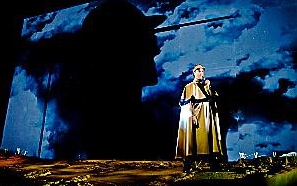Tricks of the lighting..
Reporter: Paul Genty
Date published: 14 March 2012

Moorland pause for Holmes: Gwynfor Jones plays the famous detective in the Coliseum’s evocative production of The Hound of the Baskervilles
Scroll down for Video
THE HOUND OF THE BASKERVILLES
(Lawrence Batley Theatre, Huddersfield, to Saturday)
BOUND over the moor — albeit Saddleworth not Dartmoor — and the out-and-about Coliseum springs up in yet another theatre while in exile from its Oldham base.
After two excellent home-grown productions here’s a third — though largely courtesy of remarkable stage design company Imitating the Dog.
Arthur Conan Doyle’s big black shaggy dog story is, in actor and writer Clive Francis’s adaptation, part serious and sometimes a little too flippant for its own good.
But the over-familiar show takes on an entirely new dimension thanks to director Kevin Shaw’s masterstroke — hiring experimental design company ItD to create the show’s overall look.
The result, as in Imitating the Dog’s previous shows, takes theatre out of the realm of static sets and into that of movies and photo-imagery.
Instead of backcloths and changing sets, the stage is built with highly sophisticated combinations of moving and still pictures, graphics and light trained on basically flat walls. ItD has been doing this sort of thing for more than a decade — in fact this show represents only part of what they can do.
With evocative music and precise sound effects the result can be astonishing, taking away the boundaries of the stage and replacing them with portrait-lined, wallpapered walls, or cavernous rock formations, or bleak open moorland with brooding clouds, or a railway station, or a cosy study with a blazing fire, or a window looking out on to falling rain. The transitions are seamless and always remarkable.
In one scene — surely included so the designers can show off — the actors even play a game of billiards, their cues striking projected balls on a filmed table!
The whole thing is both brilliant and often beautiful, and certainly picks up this fairly mundane drama and makes it watchable and entertaining — even the hound is threateningly created from shadows and outlines. If this sounds like the actors take a bit of a back seat, then that’s partly true. Leigh Symonds is an effective Watson while Gwynfor Jones (apologies: not Evans, as he was referred to in print) is a little superficial and rushed as Holmes.
The supporting players — Amy Ewbank, Steven O’Neill and Robin Simpson — are all hard-working across several roles. But it’s clear that this time, the staging is the star.
Most Viewed News Stories
- 1‘New’ town hall due to open to public for first time after full cost of major refurb project...
- 2Police issue appeal after woman dies after being found unconscious on road on Oldham/Tameside
- 3Former pub ‘left to rot’ for years is finally demolished
- 4‘Overpaid’ councillors speak out after payment error
- 5Saddleworth Rangers Girls enjoy dream day out at the iconic Wembley Stadium




